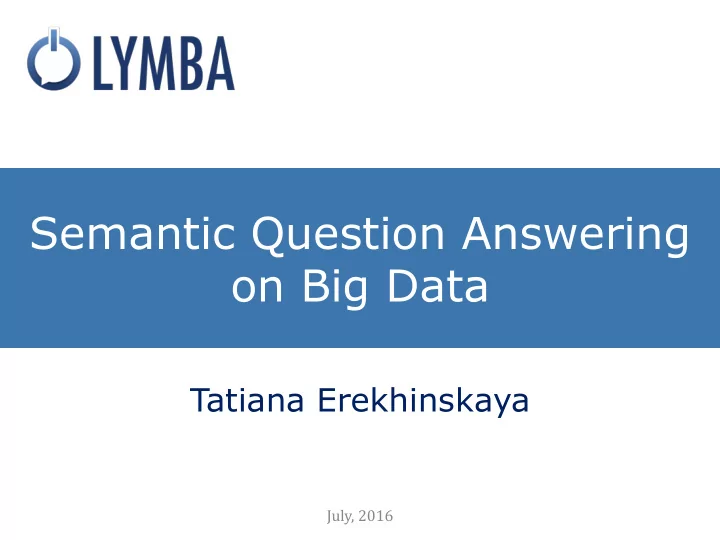

Semantic Question Answering on Big Data Tatiana Erekhinskaya July, 2016
The Goal Challenge: • Find answers to complex questions in large structured and unstructured data resources • Sample question: List Chinese researchers who worked with Kuznetsov, have publications on Zika virus and studied in US Solution : • Convert data into RDF storage • Convert questions into SPARQL
Outline • System Architecture • NLP & Semantic Parsing • RDF Representation • Plain English Query to SPARQL • Experiments & Results • Use Cases & Future Work
System Architecture Semantic Semantic RDF to RDF to SPARQL Store User Input Question Docs Question Deep Knowledge Processing NLP Extraction
Natural Language Processing
Concept Extraction • Hybrid approach combines machine learning classifiers, cascade of finite-state automata, and lexicons • Uses existing medical ontologies: MeSH, SNOMED and UMLS Metathesaurus • 80+ types of named entities: demographics, disease, symptom, dosage, severity, time course, onset, alleviating and aggravating factors
Semantic Parsing • Extracts 26 predefined binary relation types: AGENT, THEME, LOCATION, TIME, etc. • Maximum granularity, not limited to verb arguments: VALUE, PROPERTY, QUANTITY • Robust basic representation, not for end users POSSESSION QUANTITY VALUE 100 subjects with type 2 diabetes PROPERTY
Semantic Calculus • Defines how and under what conditions a chain of relations can be combined into a high level custom relation • Axioms: Possession(c1;c2)&ISA(c1, disease) & ISA(c2; organism) HasDisease(c1; c2) HAS_DISEASE QUANTITY 100 subjects with type 2 diabetes SEVERITY
RDF & SPARQL
RDF Representation • 6.3 MB of text → 13 M triples, 1 GB of RDF XML • Keep only relations of interest and tokens that participate in these relations • For tokens: named entity type or is- event flag, lemma, synset, and reference sentence
Reasoning on the RDF Store • OWLPrime • SameAs: mentions • Lexical chains: Wordnet-based relation sequence
Question Processing • Full NLP & semantic parsing • Expected answer type recognition (_human or organization, _date or _time, etc.) • Answer type terms “ which cartel ” • Maximum entropy model
SPARQL Query Formulation
Query Relaxation • Synset relaxation: include hyponyms, parts, derivations • On empty results: drop variable-description triples and semantic relations with little importance
Experiments & Results
Experimental Data • Illicit Drugs domain • 584 documents: Wikipedia + documents • 6.3 MB of plain text • 6,729,854 RDF triples • 546 MB of RDF XML
Results: Question Answering 344 questions Free text-search: 47% MRR Semantic Approach: 66% MRR Factoid: 85% MRR Definition: 78% MRR List: 68 % MRR
Results: NL to SPARQL 34 manually annotated questions • SELECT clauses: 85% • WHERE clauses on triple level: 78% • WHERE clauses on question level: 65% Relaxation usage: 68% of queries inSynset-relaxation sufficient for 31%
Error Analysis 73% caused by faulty or missing semantic relations 16% caused by query conversion: yes/no questions, and procedural questions
Conclusion Use Cases • Processing Pubmed for quality measures • National Security: terrorism, law enforcement • Foreign languages Future Work • Integration with LinkedData • Rapid Customization
Recommend
More recommend